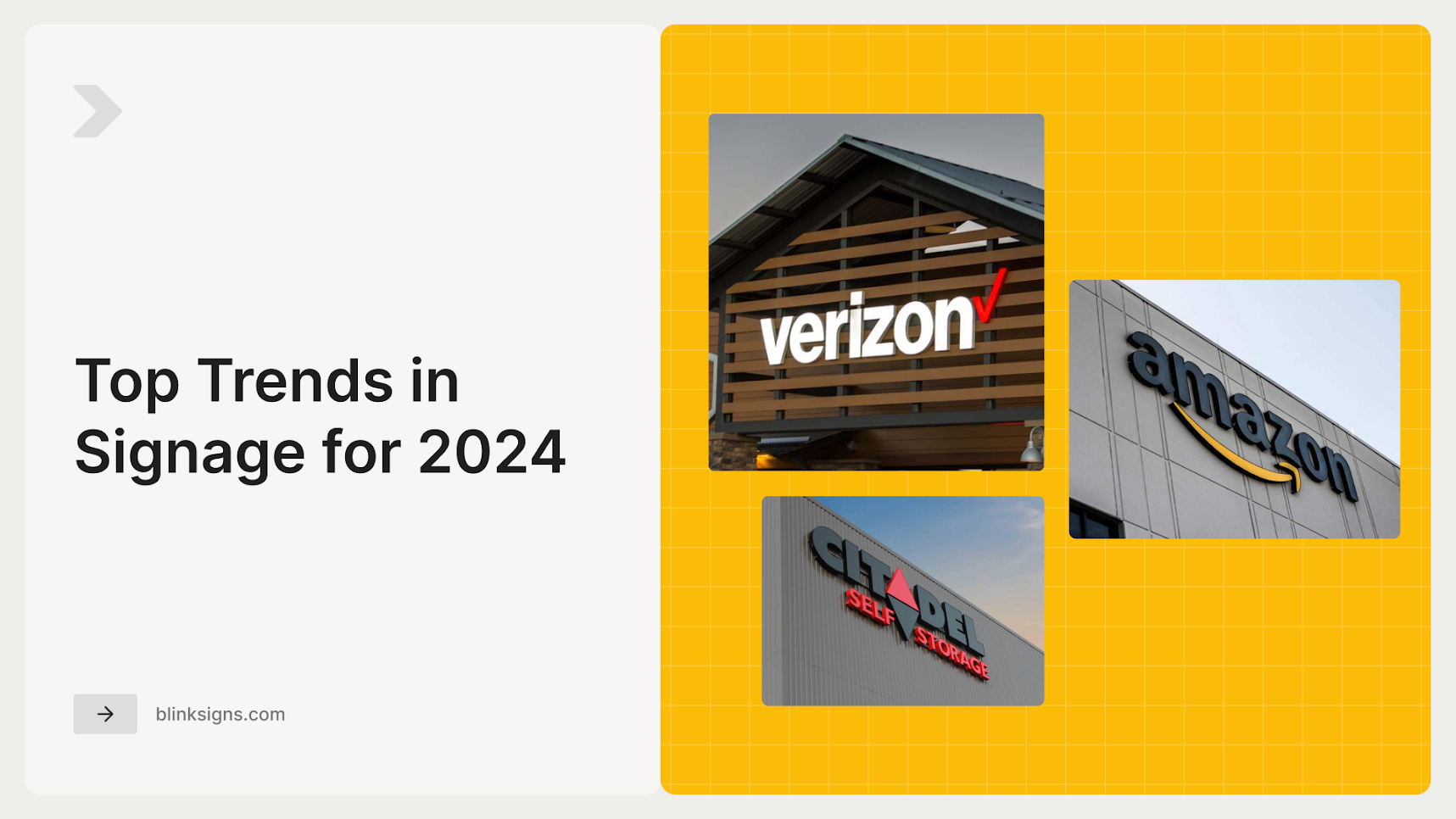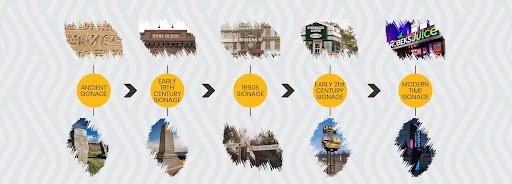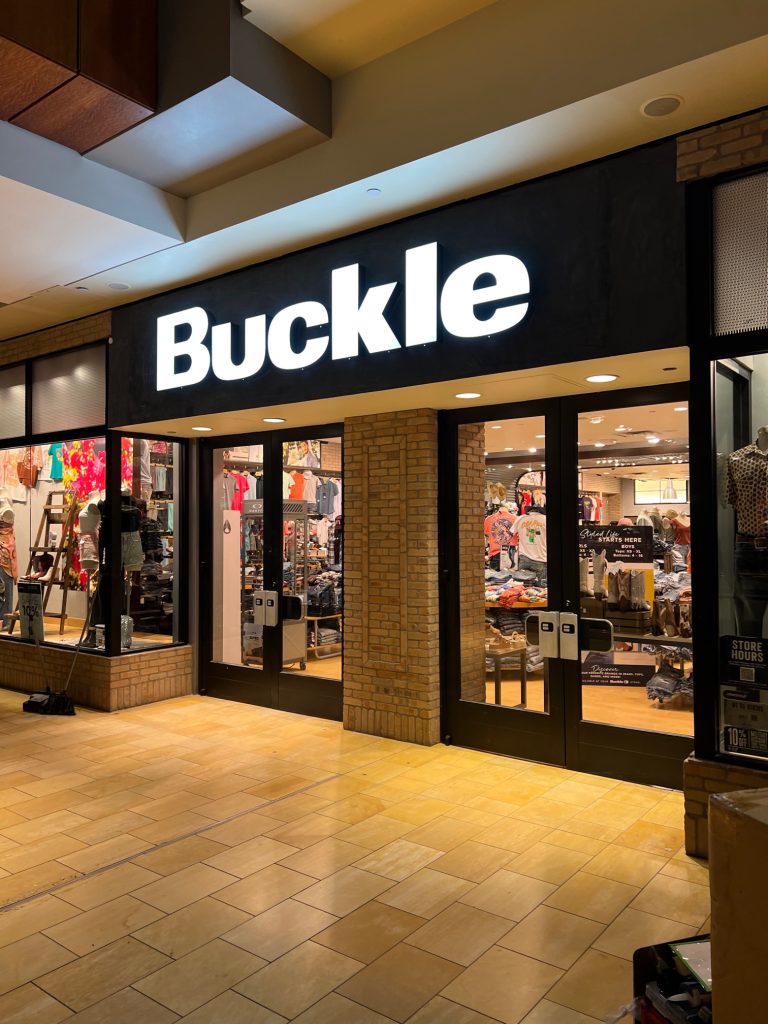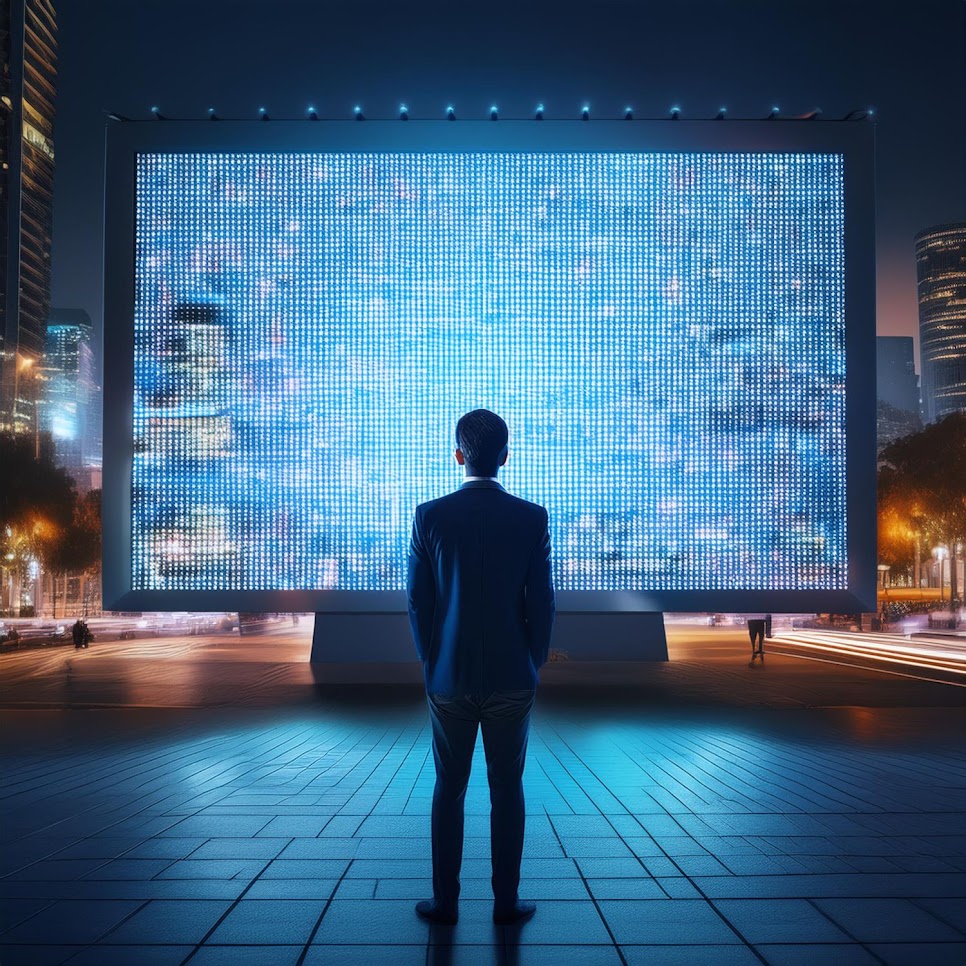
Top Trends in Signage for 2024
We’re seeing dynamic changes in the top trends in signage for 2024. Expect digital signage trends to evolve with increased interactivity, improved aesthetics, and enhanced content management systems. Blinksigns anticipates a surge in eco-friendly signage solutions, including solar-powered and biodegradable signs.
A more profound commitment to sustainability encompasses material selection and greener manufacturing processes. Advancements in LED and the integration of augmented reality make for engaging displays. We’re just scratching the surface; there’s so much more to explore in upcoming trends in the coming year. Do stick around to discover what the future holds for signage!
Digital Signage Industry Evolution

Digital Signage Industry Evolution
Digital signage solutions evolve unprecedentedly, transforming how businesses communicate with their audiences. The increased signage responsiveness and improved digital aesthetics keep viewers engaged, while advanced content management systems streamline updates and changes.
Signage cybersecurity has also become paramount, protecting valuable data from breaches. Augmented reality integration is now a game-changer, offering interactive and immersive experiences. Blinksigns is also seeing a shift towards cloud-based digital signage, providing businesses with increased flexibility and reduced costs.
Signage analytics helps businesses use digital signage software to understand viewer behavior better, leading to more effective messaging. Additionally, adaptive displays are emerging, adjusting content based on factors like time of day or weather. These trends are shaping the future of digital signage.
Eco-Friendly Signage Solutions
Blinksigns delves deeper into our discussion of 2024’s top signage trends; it’s crucial to contemplate the increasing importance of eco-friendly signage solutions.
These factors significantly impact our environment, from using sustainable materials and green manufacturing processes to the advantages of reusable signage and its associated costs.
Let’s explore these aspects further, recognizing their pivotal role in shaping a greener future for the signage industry.
Sustainable Materials in Signage
With the incredible power of sustainable materials, we’re witnessing a significant shift towards eco-friendly signage solutions in the industry. Recyclable materials and biodegradable signs are now the go-to choices for businesses aiming to reduce their carbon footprint.
Solar-powered signage is gaining traction, eliminating the need for traditional energy sources. Compostable billboards and bio-plastic banners are transforming the advertising landscape, offering eco-friendly alternatives that don’t compromise visibility. Hemp-based signs and zero-waste signage further push the boundaries of what’s possible in green advertising.
Even the inks used are revolutionizing, with plant-based inks replacing conventional petrochemical varieties. These sustainable materials are genuinely redefining the future of signage.
Green Manufacturing Processes
Building on sustainable materials, Blinksigns is also seeing a surge in eco-friendly manufacturing processes within the signage industry. Companies are now going beyond green certifications, prioritizing renewable energy in manufacturing, waste reduction, and low-emission production to reduce their carbon footprint.
Organic inks are favored over traditional ones due to their lower environmental impact. With lighting, energy-efficient solutions are being adopted that reduce electricity consumption and enhance the longevity of signs. Solar-powered signs, with their autonomous capabilities, are becoming increasingly popular for customer experience.
These green manufacturing processes aren’t just good for the environment and demonstrate a company’s commitment to sustainability, which is a plus in today’s eco-conscious market.
Reusable Signage Advantages
Therefore, moving in the same sustainable direction, let’s explore the benefits of reusable signage, a powerful eco-friendly solution in the signage industry.
With enhanced signage durability, these signs withstand time and elements, offering long-term savings. Their design flexibility allows for regular updates, maintaining brand consistency while providing versatility benefits.
We can easily tweak messages or graphics without investing in new signage, ensuring space efficiency. Maintenance ease is another advantage, as cleaning and updating these signs is a breeze.
Eco-Friendly Signage
Now, let’s explore the costs associated with eco-friendly signage solutions.
Indeed, cost efficiency is a significant factor. While there may be an initial investment, recycling initiatives and renewable sources can drastically reduce energy consumption and maintenance costs. Green certifications also add value by demonstrating a commitment to reducing carbon footprint.
However, it’s essential to be wary of greenwashing pitfalls. Claiming to be ‘green’ without substantiating actions can lead to reputational damage and financial loss.
Opting for eco-friendly signage with Blinksigns isn’t just about being environmentally conscious; it’s also about long-term savings and credibility. So, despite the initial costs, the benefits of these solutions certainly offset the expenditure in the long run.
Impact on Environment
Shifting our focus on costs, let’s examine the environmental impact of eco-friendly signage solutions. They significantly reduce our carbon footprint by utilizing energy-efficient technologies and materials. These solutions support recycling initiatives and effective waste management, further reducing pollution.
Companies aiming for green certifications often opt for eco-friendly signage, demonstrating their commitment to addressing climate change and deforestation prevention. They’re saving money and doing their part to save our planet.
Interactive Signage Breakthroughs

signsense by Blinksigns
As we move forward, let’s focus on breakthroughs in interactive signage.
We’ll explore smart signage innovations, discuss the future of signage interaction, and examine how interactivity boosts engagement.
Expect a thrilling journey into how these dynamic signs revolutionize communication and marketing strategies.
Smart Signage Innovations
Exploring the domain of Smart Signage Innovations, we’re witnessing a surge in interactive signage breakthroughs that are revolutionizing how businesses communicate with their customers. Signage analytics are now providing businesses with valuable data on customer engagement.
IoT integration and mobile connectivity allow real-time updates and personalized messages. Features like gesture recognition and facial detection aren’t just sci-fi anymore; they’re enhancing the user experience by creating dynamic content and immersive experiences. Touchless interfaces are another breakthrough, offering a hygienic and user-friendly option.
“Sign Sense is a pioneering device designed to help you monitor and maintain your business signboard’s health. Blinksigns”
The advancements in intelligent signage aren’t only captivating customers but also providing businesses with new ways to deliver compelling, relevant, and interactive content. We’re truly in an era where intelligent signage innovations are redefining the industry.
Future of Signage Interaction
Building on the recent advancements in intelligent signage, let’s now cast our gaze forward to envision the future for interactive signage breakthroughs.
We’re anticipating revolutionary strides in gesture recognition, enabling us to interact with signage with a wave. Coupled with sensory integration and haptic feedback, we’ll feel the response to our actions, blurring the lines between the virtual and the real.
Augmented reality will transform our surroundings, making ordinary signage experiences extraordinary. Voice activation, facial recognition, and touchless interaction drive user engagement, making signage more personalized.
Plus, real-time updates will keep the content relevant and current, ensuring that our signage continues to be a powerful communication tool.
Boosting Engagement with Interactivity
We’re harnessing the power of interactive signage breakthroughs to boost engagement, making connections with audiences more dynamic and personalized than before. Interactive billboards, for instance, are capturing audience’s attention with touch-based interfaces and adaptive layouts. These responsive designs aren’t only engaging but also track engagement analytics, providing valuable insight into user interactions.
Virtual signage is another trend. These can display user-generated content, making the audience part of the experience and boosting engagement significantly. Additionally, beacon-enabled signs make interactions even more personalized, pushing relevant content based on the user’s location and behavior.
The future is clear: interactivity isn’t a fad but a potent tool for engaging audiences in ways we’ve never seen before.
Technological Advancements in Signage
In 2024, we’re set to witness groundbreaking technological advancements that will revolutionize the signage world. Signage automation will take centre stage, streamlining the creation and management of signs.
Projection mapping and holographic displays will transform flat surfaces into dynamic, 3D visual experiences. Augmented reality applications will overlay digital information onto the real world, enhancing user engagement and interaction.
Solar-powered signs and the use of biodegradable materials will reflect the industry’s commitment to sustainability. LED advancements will offer brighter, energy-efficient displays with superior longevity.
Rise of Personalized Signage
We’re seeing a surge in the trend of personalized signage in recent years. The ability to customize signage to reflect brand identity has become a game-changer in the industry.
As we look forward, we’ll discuss how digital personalization impacts signage and what the future of personalization might hold.
Customizing Signage for Brands
Increasingly, brands are turning to personalized signage as a powerful tool to stand out from the crowd and connect more authentically with their target audience.
Brand aesthetics play a significant role, with logo incorporation becoming pivotal. Color psychology influences decisions, with brands choosing hues that resonate with their messages. Font considerations and shape preferences are also essential, contributing to visual identity.
The cultural significance of designs is now factored in, ensuring that signs resonate well within specific demographics. Local regulations are considered, too, ensuring compliance and maximizing billboard strategies.
This trend is shaping the future of signage, making it an exciting time to see how brands will differentiate themselves.
Personalized Digital Signage Impact
Building on this growing interest in customization, the impact of personalized digital signage is becoming a game-changer in the industry. Advanced technologies are enabling a revolution in how businesses interact with their audience.
- Signage analytics and data integration help businesses understand audience behavior optimizing their strategies.
- Personalization software leads to dynamic content creation, making each piece of signage unique to the viewer.
- Audience targeting becomes more precise, allowing personalized messaging to enhance the user experience.
- Real-time updates in content management systems guarantee the most relevant and current information is displayed.
- The seamless integration of these elements results in an unparalleled level of personalization that resonates deeply with viewers.
We’re genuinely witnessing the rise of personalized signage.
The Future of Personalization
As we peer into the future of personalization, it’s evident that the rise of personalized signage will continue to reshape the industry’s landscape. Personalized aesthetics, driven by design psychology, are becoming a staple in user-centric personalization. We’re seeing data-driven personalization being leveraged more than ever, with niche targeting in full swing. Yet, with these advancements, we’re also encountering personalization challenges.
Personalization technology is revolutionizing how we communicate visually, but it’s essential to tread the fine line of personalization ethics. As we move forward, it’s not just about delivering the right message at the right time but also respecting user privacy and data. The future is indeed exciting, but it demands a thoughtful approach.
Impact of VR and AR on Signage

AR VR in signage industry
We’re seeing a significant shift in the signage industry with the introduction of Virtual Reality (VR) and Augmented Reality (AR). These technologies are reshaping how we perceive and interact with signs in our surroundings.
- VR signage implementation transforms traditional signage into immersive advertisements, creating virtual environments that draw in consumers.
- AR content creation is becoming a staple in modern signage, offering interactive and engaging experiences.
- Augmented reality analytics provide valuable insights into consumer behavior, helping businesses refine their AR signage strategies.
- Despite VR design challenges and AR signage limitations, we’re witnessing innovative solutions that enhance user experience.
- Future VR/AR predictions suggest a world where signs are interactive, personalized, and immersive, revolutionizing how businesses communicate with customers.
Outdoor Signage Innovations
Let’s now turn our attention to the exciting innovations in outdoor signage.
We’re about to explore the rise of interactive digital displays, the push for eco-friendly signage solutions, and the latest advancements in neon technology.
These trends are reshaping the way we communicate and interact with our environment.
Interactive Digital Displays
In 2024, you’ll see a massive surge in interactive digital displays, a prominent trend in outdoor signage innovations. These displays will leverage advanced technology to provide a next-level user experience.
- Gesture recognition and touchless operation will allow for seamless interaction, eliminating the need for physical contact with the display.
- High display resolution will guarantee crisp and clear visuals, enhancing visual aesthetics.
- Content management and data integration will be streamlined, offering real-time updates and relevant information.
- Weatherproof displays will guarantee longevity and functionality in various climatic conditions.
- However, these advancements may pose maintenance challenges due to their complex nature.
The future of signage looks bright, with interactive digital displays leading the way. Stay tuned for our subsequent discussion on ‘Eco-Friendly Signage Solutions‘.
Advancements in Neon Technology
Beyond eco-friendly solutions, we’re witnessing significant advancements in neon technology, transforming the landscape of outdoor signage innovations. The retro neon resurgence isn’t just a nostalgic nod to the past. Improvements in:
- Neon longevity: New techniques are leading to longer-lasting signs.
- Color dynamics: Advances allow for a broader spectrum of vibrant colors.
- Neon safety: Enhancements in construction and installation are reducing risks.
- Energy efficiency: Modern neon signs are more eco-friendly than their predecessors.
- Neon maintenance: Improved durability translates to decreased upkeep costs.
When comparing costs, the advantages of longevity and maintenance savings outweigh the initial expense for neon. These developments and increasing neon artistry promise a bright future for this timeless medium.
AI-Driven Signage Systems
Harnessing the power of artificial intelligence, we’re seeing a revolutionary shift in the signage industry towards AI-driven systems. These systems use AI algorithms and machine learning to offer dynamic messaging and data-driven personalization. They’re not just displaying messages; they’re predicting them.
Predictive analytics, a cornerstone of these systems, enables them to anticipate user needs and preferences. Behavior tracking forms another vital part of this AI integration, allowing signs to adapt based on user habits and trends. Meanwhile, content automation helps maintain the relevance and timeliness of messaging, making each interaction more impactful.
With AI-driven signage systems, we’re moving towards a future where each sign isn’t just a passive display but an intelligent, responsive communicator.
Progress in Wayfinding Signage
Just as AI is reshaping the signage landscape, advancements in wayfinding signs are also making a significant impact. We’re seeing:
- Innovative applications that make wayfinding signs more interactive and engaging.
- Stricter signage regulations ensure user-friendly designs and straightforward wayfinding typography.
- Aesthetic considerations are becoming increasingly important, with location-specific signage that seamlessly blends into the environment.
- Cultural influences inspire designs, with multilingual options becoming standard to cater to diverse populations.
- A rise in digital solutions, offering dynamic, real-time updates for users.
These advancements are transforming how we navigate spaces, making them more accessible and more intuitive. As we continue to innovate, we’ll see even more remarkable progress in the wayfinding signage field.
Transformative Retail Signage Trends
As we explore the world of retail signage, it’s clear that the trends emerging in 2024 are nothing short of transformative. Signage aesthetics are evolving beyond brand promotion to tell compelling stories, enhancing retail branding.
Color influences are more thoughtful, with palettes that evoke specific emotions and reactions. Typography trends lean towards bold, legible fonts, prioritizing visibility factors.
Signage maintenance is now easier thanks to durable materials and easy-to-update digital platforms. Lighting options have also improved, with energy-efficient LED lights becoming the norm.
The Future of Signage Design

Future of Signage
Building on these transformative trends, we’re now seeing a shift towards even more innovative signage design in the future. The influence of evolving aesthetics, technological advancements, and changing user preferences shapes the future of signage aesthetics.
Here are some trends we’re excited to see:
- Minimalist designs: Stripping back to basics with clean lines and simple color palettes.
- 3D Signage: Adding depth and dimension to signs for a more engaging experience.
- Illuminated signs: Using light to enhance visibility and create a dramatic effect.
- Typography trends: Exploring different font styles, sizes, and arrangements.
- Retro signage: A nostalgic nod to the past with vintage fonts and color schemes.
Additionally, we anticipate seeing a rise in graffiti-inspired signs and architectural signage, pushing the boundaries of traditional sign design.
Frequently Asked Questions
What Is the Expected Cost of Implementing New Signage Trends in 2024?
As an award-winning company, budgeting considerations, funding sources, and cost-effectiveness analysis will be critical. Installation expenses, material cost trends, pricing forecasts, and vendor negotiation strategies will all impact the expected cost of implementing new trends.
How Does Local Legislation Impact Signage Display and Design?
We’re seeing that local legislation significantly impacts signage display and design. Variances in-laws, regional discrepancies, and sizing regulations limit designs, making compliance essential. Failing to secure permits can lead to legal consequences. Environmental impacts are also considered.
What Are the Maintenance Requirements for the New Signage Technologies?
Blinksigns is noticing that maintenance for new signage technology involves digital cleaning, durability assessments, software updates, and hardware upgrades. Power consumption, weather resistance, physical protection, and troubleshooting techniques are also essential factors we’re considering.
How Do 2024 Signage Trends Affect Accessibility for Visually Impaired Individuals?
Braille integration, audio descriptions, tactile maps, and high-contrast colors improve accessibility. Non-visual cues, extensive print options, and assistive technology compatibility also follow inclusive design principles, making signs more user-friendly for visually impaired individuals.
Conclusion
As we look ahead, it’s clear that signage is getting a significant upgrade. The future is digital, eco-friendly, and interactive, thanks to technological innovations with Blinksigns.
Personalized and AI-driven signs are emerging, transforming the way we navigate spaces. Retail signage is also evolving quickly, with design playing a critical role.
These trends represent the exciting future of signage, promising a more dynamic, sustainable, and user-friendly experience. Let’s embrace these changes and look forward to what’s next.